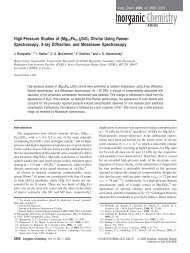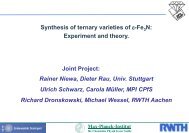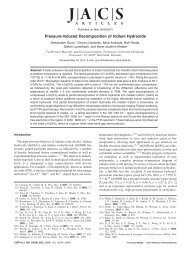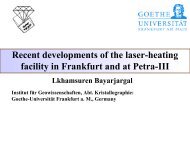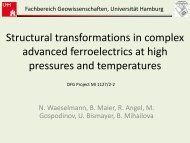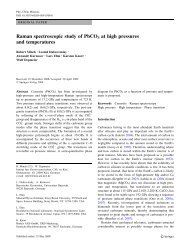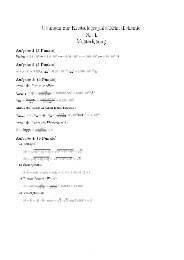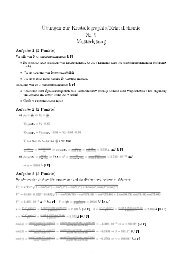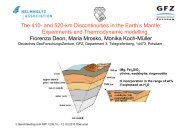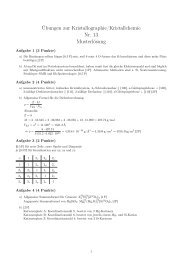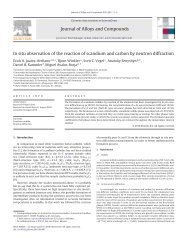Synthesis and properties of oxygen-bearing c-Zr3N4 and c-Hf3N4
Synthesis and properties of oxygen-bearing c-Zr3N4 and c-Hf3N4
Synthesis and properties of oxygen-bearing c-Zr3N4 and c-Hf3N4
You also want an ePaper? Increase the reach of your titles
YUMPU automatically turns print PDFs into web optimized ePapers that Google loves.
machining <strong>of</strong> low-carbon steels [11]. Titanium mononitride, in turn,<br />
is a well-known hard wear-resistant material which is traditionally<br />
used in mono- <strong>and</strong> multilayer coatings <strong>of</strong> cutting <strong>and</strong> milling<br />
tools because it considerably increases their service life [12,13]. The<br />
films <strong>of</strong> pure c-Zr 3N 4 were prepared via the technique <strong>of</strong> physical<br />
vapour deposition (PVD) by applying a modified filtered cathodic<br />
arc method [11]. The authors were able to control the stoichiometry<br />
<strong>and</strong> the structure <strong>of</strong> the nitrides <strong>and</strong> to deposit stoichiometric -ZrN<br />
or Zr 3N 4 with either orthorhombic or cubic structure. These results<br />
demonstrated a great potential <strong>of</strong> c-M 3N 4 for industrial application<br />
as hard wear-resistant coatings.<br />
Very recently we succeeded in synthesis <strong>of</strong> macroscopic<br />
amounts (>1 mm 3 ) <strong>of</strong> <strong>oxygen</strong>-<strong>bearing</strong> cubic zirconium(IV) nitride,<br />
c-Zr 2.86(N 0.88O 0.12) 4 [14], as well as <strong>of</strong> c-Hf 3N 4 at high pressures<br />
<strong>and</strong> temperatures. The obtained materials were examined using the<br />
XRD-, TEM-, EPMA- <strong>and</strong> SEM-techniques. The results are described<br />
below. We also present accurate values for B 0 <strong>of</strong> c-Zr 2.86(N 0.88O 0.12) 4<br />
<strong>and</strong> c-Hf 3N 4 derived from their equations <strong>of</strong> state (EOS), V(P),<br />
measured on compression at RT [15,16]. Applying nanoindentation<br />
technique we obtained the reduced elastic modulus, Er, <strong>and</strong><br />
hardness, H, <strong>of</strong> c-Zr 2.86(N 0.88O 0.12) 4. Combining the results for B 0<br />
<strong>and</strong> Er we derived the shear modulus, G 0, for c-Zr 2.86(N 0.88O 0.12) 4<br />
[15]. Hardness <strong>and</strong> fracture toughness <strong>of</strong> porous <strong>oxygen</strong>-<strong>bearing</strong> c-<br />
Zr 3N 4 were determined from Vickers indentation testing. Finally,<br />
the first results on thermal expansion <strong>of</strong> c-Zr 2.86(N 0.88O 0.12) 4 from<br />
high-temperature XRD measurements will be described.<br />
2. Experimental methods<br />
The high-pressure high-temperature synthesis <strong>of</strong> macroscopic amounts <strong>of</strong><br />
<strong>oxygen</strong>-<strong>bearing</strong> c-<strong>Zr3N4</strong> <strong>and</strong> <strong>of</strong> c-<strong>Hf3N4</strong> was performed in a multi-anvil apparatus.<br />
As a starting material we used nanocrystalline powders <strong>of</strong> nitrogen-rich zirconium<br />
<strong>and</strong> hafnium nitrides (N:M > 1.33) having distorted NaCl-type structure [17]. The<br />
starting materials in platinum capsules were compressed to 12 GPa <strong>and</strong> heated<br />
up to 1900 K, kept at the maximum temperature for about 20 min <strong>and</strong> quenched.<br />
The recovered products were characterized using an electron probe micro-analyzer<br />
CAMECA SX-50, a scanning electron microscope Philips XL30 FEG <strong>and</strong> a TEM Philips<br />
CM20 equipped with an EDX-detector. The powder X-ray diffractograms <strong>of</strong> highpressure<br />
nitrides were collected using a STOE STADI P diffractometer with Mo-K1<br />
radiation.<br />
The EOS <strong>of</strong> c-Zr2.86(N0.88O0.12)4 <strong>and</strong> c-<strong>Hf3N4</strong>, synthesized in a multi-anvil apparatus<br />
[14] <strong>and</strong> in a LH-DAC [6], respectively, were measured on compression at RT<br />
in a DAC to about 45 GPa. Argon was used as quasi-hydrostatic pressure medium.<br />
Pressure values were determined from the EOS <strong>of</strong> crystalline argon [18]. Specific<br />
volumes <strong>of</strong> the sample material <strong>and</strong> <strong>of</strong> argon at high pressures were derived from<br />
the EDX powder diffraction patterns measured using a polychromatic synchrotron<br />
radiation (beam-line F3 at the HasyLab, DESY, Hamburg, Germany).<br />
Nanoindentation testing was carried out on a polished surface <strong>of</strong> the porous<br />
polycrystalline c-Zr2.86(N0.88O0.12)4 using Nanoindenter XP equipped with the continuous<br />
stiffness measurement (CSM) module [19]. Experiments were performed<br />
to two maximum loads <strong>of</strong> about 23 mN <strong>and</strong> 14 mN which corresponded to maximal<br />
indentation depths <strong>of</strong> about 260 nm <strong>and</strong> 210 nm, respectively. In the Vickers<br />
hardness measurements the loads between 0.49 N <strong>and</strong> 9.8 N were applied. Thermal<br />
expansion <strong>of</strong> c-Zr2.86(N0.88O0.12)4 was examined to 873 K using a STOE STADI P X-ray<br />
diffractometer equipped with a curved imaging plate position sensitive detector.<br />
3. Results <strong>and</strong> discussion<br />
The XRD examination <strong>of</strong> the zirconium nitride product synthesized<br />
in a multi-anvil apparatus showed only lines <strong>of</strong> a cubic<br />
phase having Th 3P 4-type structure (Fig. 1). The EPMA revealed<br />
presence <strong>of</strong> a minor amount <strong>of</strong> <strong>oxygen</strong> (mass fraction <strong>of</strong> 0.024).<br />
Since in the TEM investigations no amorphous oxidic layers were<br />
observed on the grain surfaces, we concluded that <strong>oxygen</strong> was<br />
incorporated in the crystal structure <strong>and</strong> the composition <strong>of</strong> the<br />
product could be expressed as Zr 2.86(N 0.88O 0.12) 4. This suggested<br />
formation <strong>of</strong> an <strong>oxygen</strong>-<strong>bearing</strong> cubic zirconium(IV) nitride <strong>of</strong> the<br />
general composition Zr 3−u(N 1−uOu) 4. Here, formation <strong>of</strong> vacancies<br />
at the cation sites required by the condition <strong>of</strong> electrical neutrality<br />
is taken into account. This supposition was verified by a<br />
D.A. Dzivenko et al. / Journal <strong>of</strong> Alloys <strong>and</strong> Compounds 480 (2009) 46–49 47<br />
Fig. 1. Powder XRD patterns <strong>of</strong> c-Zr2.86(N0.88O0.12)4 (top) <strong>and</strong> c-<strong>Hf3N4</strong> (bottom) synthesized<br />
at 12 GPa <strong>and</strong> 1900 K in a multi-anvil apparatus. The Bragg positions <strong>of</strong> the<br />
Th3P4-type phases are displayed below the patterns. The asterisks denote the XRD<br />
reflexes from an oxidic impurity in the hafnium nitride sample.<br />
full-pr<strong>of</strong>ile Rietveld structure refinement <strong>of</strong> the XRD data (Fig. 1)<br />
[14]. The lattice parameter <strong>of</strong> c-Zr2.86(N0.88O0.12) 4 was found to<br />
be a0 = 675.49(1) pm which is slightly larger than a0 = 674.0(6) pm<br />
reported earlier for c-<strong>Zr3N4</strong> [6]. This observation contradicts to<br />
an expected decrease <strong>of</strong> a0 due to both substitution <strong>of</strong> N3− by<br />
O2− anions having smaller ionic radius <strong>and</strong> formation <strong>of</strong> cation<br />
vacancies. However, recent theoretical calculations have shown<br />
that incorporation <strong>of</strong> <strong>oxygen</strong> in c-M3N4 (M = Zr or Hf) results in<br />
a weakening <strong>of</strong> the cation-anion bonding [20]. This leads to reduction<br />
<strong>of</strong> elastic moduli <strong>of</strong> <strong>oxygen</strong>-<strong>bearing</strong> c-M3N4 <strong>and</strong>, on reaching<br />
<strong>of</strong> a critical <strong>oxygen</strong> concentration, to expansion <strong>of</strong> the unit cell [20].<br />
The formation <strong>of</strong> cation vacancies, however, was not considered in<br />
the calculations.<br />
The EPMA detected a minor amount <strong>of</strong> <strong>oxygen</strong> (mass fraction <strong>of</strong><br />
∼0.02) in hafnium nitride sample as well. However, in contrast to<br />
<strong>oxygen</strong>-<strong>bearing</strong> c-<strong>Zr3N4</strong>, results <strong>of</strong> XRD-, SEM- <strong>and</strong> EDX-analyses<br />
revealed the presence <strong>of</strong> a crystalline hafnium oxide or oxynitride,<br />
in addition to c-<strong>Hf3N4</strong>. The nature <strong>of</strong> the contaminating oxidic<br />
phase could not be determined unambiguously due to a low intensity<br />
<strong>of</strong> its XRD reflexes (Fig. 1). The lattice parameter <strong>of</strong> c-<strong>Hf3N4</strong> <strong>of</strong><br />
a0 = 670.2(1) pm was found to be in agreement with that reported<br />
earlier (a0 = 670.1(6) pm) [6]. Ifa0 <strong>of</strong> c-M3N4 is influenced by substitution<br />
<strong>of</strong> nitrogen by <strong>oxygen</strong> [20], it should be recognized that, in<br />
contrast to zirconium, cubic hafnium(IV) nitride precludes <strong>oxygen</strong><br />
incorporation in the structure. Influence <strong>of</strong> <strong>oxygen</strong> impurities on<br />
the lattice parameter <strong>and</strong> <strong>properties</strong> <strong>of</strong> c-M3N4 could be a subject<br />
<strong>of</strong> future experimental <strong>and</strong> theoretical work.<br />
The V(P) dependences <strong>of</strong> c-Zr2.86(N0.88O0.12) 4 <strong>and</strong> c-<strong>Hf3N4</strong> measured<br />
at RT in a DAC to about 45 GPa [15,16] are shown in Fig. 2.<br />
From the least-square fit <strong>of</strong> the Birch-Murnaghan EOS [21] to the<br />
experimental data we obtained B0 = 219(13) GPa, B ′ = 4.4(10) <strong>and</strong><br />
0



